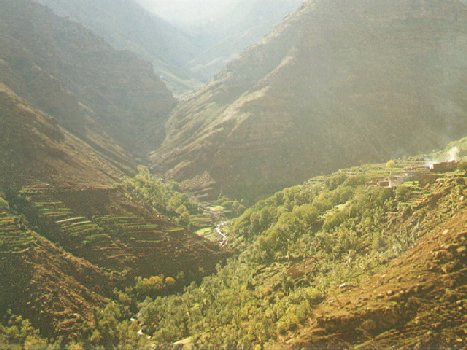| Valleys |
| Valleys are created as a result of water or ice erosion - cut by rivers or glaciers as they move downhill - or by rifting along fault lines. Glacier-cut valleys are distinguished by their broad U-shaped profile, with steep sides and flat bottoms. Many areas which are ice-free today contain glacial valleys gouged out during the last ice age, which peaked 20,000 years ago. In Europe, the Alps, the Pyrenees and the Atlantic Highlands of Scotland and Norway are dominated by glacial valleys, many of them containing long lakes dammed by glacial debris.
A glacier-cut, u-shaped, valley in the Lake District of northern England. River-cut valleys in mountain areas are narrower, with a V-shaped profile. The water flow wears away the soil and bedrock of the valley and loose material is carried downstream, itself contributing to the erosion of the river bed and banks.
River-cut, v-shaped, valleys in the Atlas Mountains of Morocco. Canyons, or gorges, are very long, deep valleys with steep walls, usually formed in arid regions where there is little rainfall to wash away the slopes, or where the rock is particularly weak, such as in limestone regions. The Grand Canyon in the southwest USA started to form when the mature, meandering Colorado River was uplifted, increasing its erosive power.
The Grand Canyon has been gouged out throuigh 1600 metre thick sediment. A rift valley is formed when land drops between two parallel faults as a result of tectonic movement. The central section of the River Rhine flows through a rift valley and the Great East African Rift Valley shows where the Somali plate is starting to split away from the main African plate. The broad valleys of the "basin and range" province of the western USA is a result of a series of half-rifts due to east-west stretching of the crust.
The Cares Gorge in northern Spain was formed first by glacier action, and then by river erosion down through the soft limestone rock. |
| Links | ||||||||||
|



